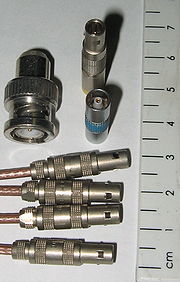
LEMO
Encyclopedia

LEMO has set several connector standards, such as the 3K.93C connector for HDTV and 00.250 connector for NIM
NIM
The Nuclear Instrumentation Module standard defines mechanical and electrical specifications for electronics modules used in experimental particle and nuclear physics...
and CAMAC.
The LEMO 00, a miniature push-pull 50Ω coaxial connector, is a standard adopted by the NIM and CAMAC standards used in nuclear and particle physics. It is used as a replacement for BNC connector
BNC connector
The BNC connector ' is a common type of RF connector used for coaxial cable. It is used with radio, television, and other radio-frequency electronic equipment, test instruments, video signals, and was once a popular computer network connector. BNC connectors are made to match the characteristic...
s in high density designs, for both analog and fast logic signals.
While LEMO connectors were generally developed as proprietary designs, the legal status of many of the older designs is not clear. For example, the LEMO UK website itself shows a standardisation date of 1970 for the popular LEMO 00 model. Any patent on that design would therefore have expired around 2000 or earlier, depending on the filing date and jurisdiction.
The 3K.93C http://www.lemo.co.uk/images/catalogue_downloads/SMPTE_Compatible_HDTV_Connection%20_System_3K-93V_Series.pdf LEMO 3K.93C Catalogue] has been adopted by the American (SMPTE 304M), Japanese (ARIB BTAS-1005B) & European (EBU R100-1999) standards organisation for HD fibre links for the Broadcast market. This has enabled other companies to copy the design using published interface details.
External links
- LEMO group company website
- LEMO UK website Showing a short history of LEMO UK.
- LEMO UK HD Fibre Links Handbook
- LEMO White Paper: Fibre optic hybrid broadcast camera systems
- LEMO HD Fibre Steadicam Cable
- LEMO Quality Cable Assemblies
- Fibre Optic Cleaning Video, how to clean LEMO fibre contacts.

